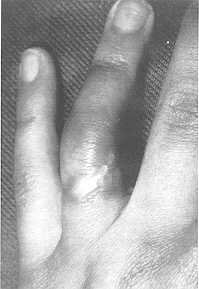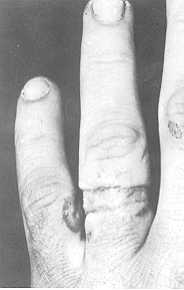| Annals of the MBC - vol. 5 - n' I - March 1992
CIRCUMFERENTIAL ELECTRIC BURNS OF THE RING FINGER
Baruchin A.M.
Plastic Surgery Service, Barzilai Medical Center, Ashkelon,
Israel
SUMMARY. Two patients sustained
circumferential burns to the fingers associated with metal rings. In both cases the
patients sustained a deep partial -thickness burn when their rings shorted the battery of
a vehicle. Our treatment regimen was entirely on an out-patient basis and consisted of
multiple daily washing, instruction in home physical therapy, and repeated clinical
examinations.
Introduction
Electrical burns associated with rings are usually deep second-degree burns which may
leave scars, cause loss of hair follicles and sweat glands, and leave permanent skin
pigmentation. We believe this is not such an uncommon occupational electric burn as some
authors have thought (1-5), and it has to be recognized by professional mechanics as well
as by the medical community.
Case reports
Case 1
A 50-year-old auto mechanic was referred to hospital suffering from a
circumferential electrical burn around his left ring-finger. The patient was working on a
car electrical system with a metal spanner which touched the positive pole of the battery,
the wedding band and the solenoid metal housing, causing a short circuit through the ring.
The patient experienced mild pain to the left ring finger. He immediately washed his hand
and sought medical attention. On examination, his left ring-finger was erythematous and
swollen, with the ring still in place. The ring was cut and removed to reveal a
circumferential burn at the proximal phalanx (Fig. 1).
No surgical procedure or hospitalization was needed. Our treatment consisted of daily
washing, instruction in physical self-therapy and periodical clinical examination. The
wound healed within 2 weeks, leaving a flat scar.
Case 2
A 32-year-old schoolteacher tried to help her husband start his car, which had a flat
battery, by using her car battery and jump leads. She operated the starter and while she
was adjusting the jump starting cables, her wedding ring shorted across the battery.

|
Fig. I Patient No. I seen a
few days after initial injury. |
|
She presented to hospital a few . hours later. The ring was removed
with a cutter, revealing a deep circumferential burn without vascular impairment (Fig. 2).
Digital sensation was normal at the finger tip. The bufn was treated conservatively with
dressing and was fully healed within 3 weeks. Full function was obtained.
 |
Fig. 2 Patient No. 2. Dorsal
aspect of ring finger at I year. |
|
Discussion
Both of these patients demonstrate the potential problem of wearing metal jewellery
around electrical current. The perspiration underneath a wedding ring serves as an
excellent conductor for the current. The three metals commonly used in rings are gold,
platinum and silver. The thermal conductivity and resistivity of each metal is shown in
Table 1. A gold ring, as can be seen, will conduct heat and electricity to a greater
degree than a platinum ring since it has a higher thermal conductivity but lower
resistivity.
DvoretAy and Silverman (2) reported similar cases. These authors were able to confirm that
a car battery could indeed cause a severe burn. A gold ring was connected to a 24 V
battery; within 1 to 2 seconds the temperature of the ring was above 1000 'C and it
started to melt. The resistance of the whole electric circuit was 0. 1 ohm (the sum of the
very low resistance of the ring, which was measured as 0.03 ohm, and the internal
resistance of the battery, which in the case of a 24 V battery is typically about 0.02
ohm, plus the resistance of the contact points, which is around 0.05 ohm). With a battery
of 24 V the current was around 240 amps, as can be calculated from Ohm's Law:
1 = V/R = 24 volts/0. 1 ohm = 240 amps
From this calculation, we can conclude that even a 12 V battery can
cause the same hazard. If a car battery is short-circuited by a metal jewellery the energy
produced can therefore cause a local deep second-degree burn. The significance of such a
burn cannot be overemphasized as it may result in serious sequelae.
THERMAL
CONDUCTIVITY |
RESISTIVITY |
(Watt/m.k. at 300
'C) |
(1 (Y1 0 m) |
400 |
3.3 |
300 |
4.6 |
73 |
21 |
|
Table 1 Thermal conductivity and
resistivity of metals |
|
RESUME L'auteur décrit deux cas de patients qui ont
subi des brélures circulaires associées A des anneaux de métal. Dans tons les deux cas
les patients ont &é atteints d'une brOlure profonde de premier on de deuxi&me
degré quand leurs anneaux ont court-circuité la batterie d'un véhicule. Les patients
ont &é traités ambulatoirement avec lavage quotidien, instructions pour la thérapie
physique chez soi, et des examens cliniques répétés.
BIBLIOGRAPHIE
- Manstein C.M., Manstein M.E., Manstein G. et al.: Circumferential electric burns of
the ring finger. J. Hand Surg. (Am.), 12: 808, 1987.
- Dvoretzky 1. Silverman N.: Ring burn - an unusual electric burn. J. Am. Acad. Dermatol.,
14: 855, 198é.
- Fisher B.K., Dvoretzky I.: Bracelet burn - an unusual electric burn. J. Br. Soc. Surg.
Hand, 8: 158, 1976.
- Regan M.W., Moss L.H.: Circumferential burns to the fingers associated with gold and
platinum rings. Burns, 12: 360, 1986.
- Attala M.F., El-Ekiabi S., AI-Baker A.: Ring burn - electric contact? Burns, 16: 69-79,
1990.
|

